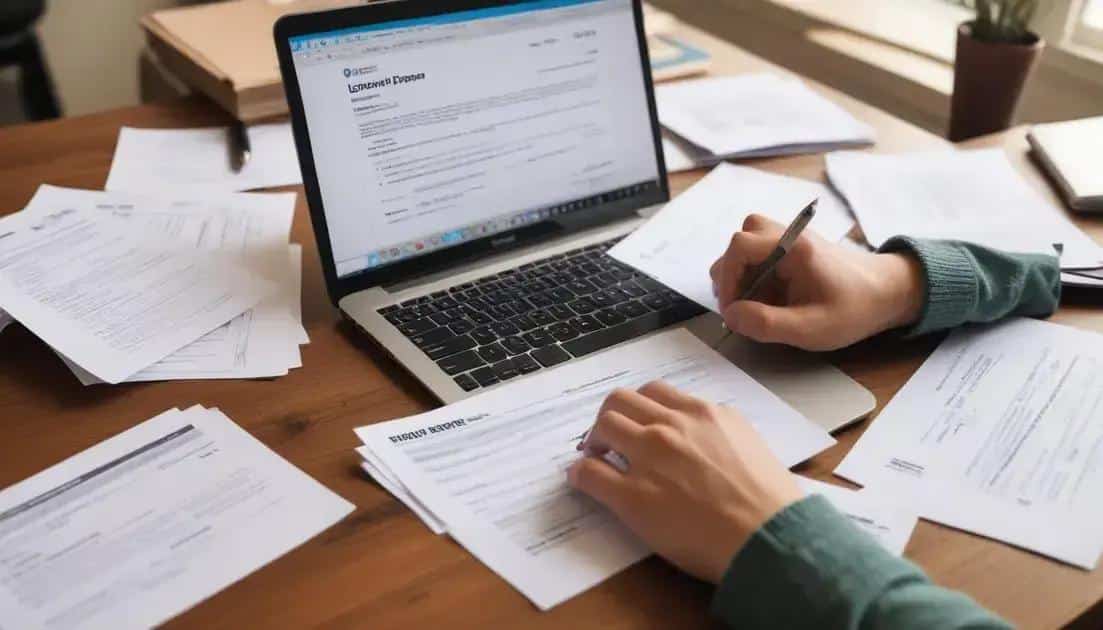Student loan forgiveness: what you need to know

Student loan forgiveness programs allow eligible borrowers to have part or all of their federal student loans canceled, helping relieve financial burdens depending on specific criteria and employment status.
Student loan forgiveness has become a hot topic as many borrowers seek relief from their financial burdens. Are you one of them? Let’s dive into the options available and see how you might benefit.
Understanding student loan forgiveness programs
Understanding student loan forgiveness programs is crucial for anyone carrying student debt. Many borrowers aren’t aware of the available options that might relieve them of their financial burdens. In this section, we will explore what these programs are and how they can benefit you.
What are student loan forgiveness programs?
These programs allow borrowers to have a portion or all of their student loans canceled. This can happen under certain conditions, such as working in public service or making consistent payments over a specific time. Knowing your options is the first step towards financial freedom.
Types of forgiveness options
- Public Service Loan Forgiveness: Available for those who work in qualifying public service jobs.
- Teacher Loan Forgiveness: For teachers who work in low-income schools.
- Income-Driven Repayment Forgiveness: For borrowers who make payments based on their income.
Each program has unique eligibility criteria and application processes. Some might even offer partial forgiveness. It’s essential to understand these details before applying. Remember, timing can significantly affect your eligibility.
You’ll want to keep track of any changes to these programs, as new legislation can impact their availability. Staying informed also helps in managing expectations. If you’re unsure about any specifics, reaching out for guidance can be beneficial.
Additionally, some borrowers might confuse forgiveness with discharge or cancellation. While similar, they can have different implications and rules. A clear understanding will help you navigate your options more effectively.
Eligibility criteria for loan forgiveness
Determining your eligibility criteria for loan forgiveness is essential to understanding if you qualify for any relief. Each forgiveness program has specific requirements that borrowers must meet to take advantage of the benefits.
Basic eligibility requirements
Generally, many programs require borrowers to demonstrate that they have made consistent payments on their loans. It’s also vital to be enrolled in a qualifying repayment plan. Furthermore, certain programs may require borrowers to work in specific professions or sectors.
- Type of loan: Most forgiveness programs apply to federal loans rather than private loans.
- Payment history: A good payment history can be crucial for meeting eligibility.
- Employment status: Some programs require full-time employment in a qualifying position.
Additionally, each program often has unique stipulations. For instance, the Public Service Loan Forgiveness program requires borrowers to work in public service for a defined period. If you are a teacher, the Teacher Loan Forgiveness program might apply, which offers forgiveness after five years in a low-income school.
Understanding these differences can significantly impact eligibility. Borrowers should review each program’s rules carefully, as a common mistake is assuming eligibility without checking the qualifications. Staying informed will help you navigate your options better.
Moreover, be aware that any changes in laws or policies can affect eligibility. Regularly checking for updates can provide you with the most accurate information.
Step-by-step application process

The step-by-step application process for student loan forgiveness can feel overwhelming, but breaking it down makes it easier. Understanding each stage helps ensure you cover all necessary steps.
Gather your documents
Before you apply, collecting the right documents is essential. These might include your loan statements, proof of income, and any records of employment. Having everything in one place will streamline your application.
Complete the application
Next, fill out the appropriate application form for the forgiveness program you are pursuing. For example, if you are applying for the Public Service Loan Forgiveness program, you’ll need to use their specific form. Make sure all information is accurate and complete.
- Double-check your details: Ensure that your name, Social Security number, and other personal information are correct.
- Job verification: You may need to confirm your employment status and the type of work you do.
- Submit on time: Each program has deadlines; missing them can delay your application.
After submitting your application, it’s crucial to monitor its status. Keep an eye on emails or letters from your loan servicer. They may request additional information or documentation to complete the process.
If your application is approved, review the terms and any next steps outlined by your servicer carefully. If denied, don’t lose hope; you can often appeal the decision or inquire about the reasons for denial. Staying informed and proactive can make a substantial difference.
Common misconceptions about forgiveness
Understanding the common misconceptions about forgiveness can help borrowers navigate their options more effectively. Many people have misunderstandings that can lead to confusion or missed opportunities.
Misconception: All loans can be forgiven
One prevalent myth is that all student loans qualify for forgiveness. In reality, most forgiveness programs apply only to federal loans, not private loans. If you have private loans, you might not have access to the same benefits.
Misconception: You can apply anytime
Some borrowers think they can apply for forgiveness whenever they want. However, many programs have specific timelines or require borrowers to complete a set number of payments before applying. Being aware of these deadlines is crucial.
- Public Service Loan Forgiveness: Requires 120 qualifying monthly payments.
- Teacher Loan Forgiveness: Requires a minimum of five consecutive years in a qualifying school.
Additionally, many borrowers believe that just submitting their application guarantees forgiveness. However, the approval process involves several checks, and it’s essential to meet all eligibility requirements.
Another common misconception is that forgiveness means you will not owe anything at all. In some cases, forgiveness may only cancel a portion of the debt. Understanding the specifics can help set realistic expectations.
Lastly, many assume that applying for forgiveness will negatively impact their credit. This is not typically the case, as long as you follow the proper procedures and continue to make payments while awaiting a decision. Clearing up these myths is key to making informed decisions.
Navigating the aftermath of loan forgiveness
Navigating the aftermath of loan forgiveness can be just as important as the application process itself. Once you have received forgiveness, understanding what comes next is essential.
Understanding your new balance
After forgiveness, it’s crucial to review your loan balance. Depending on the program, some borrowers may have remaining balances due. Knowing this can help you plan your finances better.
Impact on credit score
Receiving forgiveness does not automatically harm your credit score. In fact, paying down your debt can have a positive effect. However, any late payments prior to forgiveness might still impact your score. Monitoring your credit report after forgiveness is advisable.
- Review your credit report: Check for accuracy and ensure your forgiven loans reflect the correct balance.
- Maintain good payment habits: Continue making payments on any remaining debt to build positive credit history.
Additionally, it’s important to be aware of potential tax implications. While federal student loan forgiveness is often not taxable, some state laws might differ. Consulting a tax professional can provide clarity on what to expect during tax time.
Moreover, many borrowers find it beneficial to reassess their financial goals after forgiveness. Use this opportunity to plan for future expenses, such as homeownership or furthering your education. Having a clear plan can enhance your financial well-being.
Lastly, keep an eye out for any updates regarding your loan servicer’s policies. Changes in regulations may affect how you manage your finances moving forward. Staying informed will help you navigate your post-forgiveness landscape effectively.
FAQ – Frequently Asked Questions about Student Loan Forgiveness
What types of loans qualify for forgiveness?
Generally, federal student loans qualify for forgiveness programs, while most private loans do not.
How do I know if I am eligible for loan forgiveness?
Eligibility depends on the specific forgiveness program, employment status, and payment history. Always check the requirements for each program.
Will receiving forgiveness affect my credit score?
Forgiveness itself does not negatively impact your credit score. However, any late payments before forgiveness might still affect it.
What should I do after my loan is forgiven?
After forgiveness, review your loan balance, monitor your credit, and consider your future financial goals.






